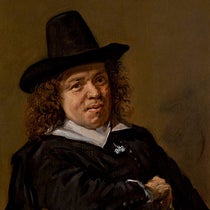Scientist of the Day - Edward Stratemeyer
Edward Stratemeyer, an American writer and publisher, was born Oct. 4, 1862, in Elizabeth, New Jersey. Stratemeyer was probably the most prolific published author of all time. If you are older, you may have encountered, and if you are younger, you may have heard of, the book serials about the Rover Boys, the Bobbsey Twins, or the Hardy Boys. The Bobbsey Twins were supposedly written by Laura Lee Hope, the Rover Boys by Arthur Winfield, and the Hardy Boys by Franklin W. Dixon. But, in fact, all three series were written by Stratemeyer, or more accurately, by the Stratemeyer Syndicate, a conglomerate of staff writers who filled out Stratemeyer's plot outlines. Stratemeyer and his crew turned out over 1300 volumes during Stratemeyer's lifetime, and the syndicate is still going strong, some 95 years after his death in 1930.
The series we commemorate today is the one dearest to my own heart, and the one appropriate for a scientific anniversary: Tom Swift. There were 38 Tom Swift books in the original series; they were credited to Victor Appleton, but there was no Victor Appleton. The first 33 books were written by Stratemeyer and ghost-writer Howard Garis from 1910 to 1930, and 5 more appeared after Stratemeyer’s death. I well remember when I was ten years old and discovered, in the basement of my grandmother's house in Blue Hill, Maine, a musty carton containing about 20 beige volumes, with titles like Tom Swift and his Electric Runabout, Tom Swift and his Wizard Camera, and Tom Swift and his Photo Telephone. I devoured those books. Tom was clever and could make anything out of anything; he had a pal, Ned Newton, who was a financial wizard; there was a sweetheart, Mary Nestor, and a father who continually told Tom his inventions wouldn't work at the beginning of each book and continually apologized at the end of each book for doubting Tom. There were villains galore, and break-neck chases, and lots of near disasters, and each volume had at least one major invention that provided the title, many of them both ingenious and plausible.
The first Tom Swift book to appear in print was Tom Swift and His Motorcycle (1910; third image) followed by four more during that year, once of which, Tom Swift and his Airship, was part of my grandmother’s treasure trove. Five more came out in 1911, and again in 1912; after that, publishing settled down to one per year. In hindsight, the most memorable volume in the series was probably no. 10: Tom Swift and his Electric Rifle (1911), because, when Jack Cover invented the first electric stun gun in the 1970s, he fashioned a name for the weapon from Tom Swift's Electric Rifle, or TSER, adding an "A" to make in pronounceable: TASER.
Although I remember really liking the Tom Swift books as a boy, I had no idea how they would stack up today. so I reread one last night: Tom Swift and his Talking Pictures (1928), one of the later volumes in the original series (fourth image). I found it quite engaging for a book that was probably written in less than a week and was aimed toward young adolescents. The story did not revolve around, as the title suggests to us, "talkies," or movies with sound, but was rather about a radio set invented by Tom that could transmit and receive images as well as sound, so that you could see what you were listening to. It was like an early form of television. The technical discussion was wonderfully imprecise, but it all sounded plausible. But most of the story was just good drama, involving a group of motion picture executives who were trying to acquire or destroy Tom's invention, which, if successful, might mean the death of their industry. Tom's lab was blown up, his best friend Ned was kidnapped, and they had to chase the perpetrators in Tom’s electric runabout (subject of an earlier book, fifth image), which had been sabotaged as well. It was all very exciting, considering that the volume is 4 years shy of being 100 years old.
![Stamped cloth cover of Tom Swift and his Talking Pictures, by Victor Appleton [pseudonym], 1928 (author’s copy)](https://assets-us-01.kc-usercontent.com:443/9dd25524-761a-000d-d79f-86a5086d4774/b563c827-ae8e-4e41-b345-20f2d6368e20/stratemeyer4.jpg?w=417&h=600&auto=format&q=75&fit=crop)
Stamped cloth cover of Tom Swift and his Talking Pictures, by Victor Appleton [pseudonym], 1928 (author’s copy)
I only have 2 volumes left from my original cache of books, the Talking Pictures volume discussed above, and Tom Swift and his Flying Boat (no. 26 of the series, 1923); I hope the others, wherever they have wandered to, are still being read by young boys who dream of coming up with the Next Big Idea.
As often happens in the writing of these pieces, I discovered at the very last moment some relevant information that will just have to wait for some other anniversary. Benjamin Gross, the Library’s historian of technology (and Vice-President and occasional contributor to these posts) came back from a visit home to Connecticut and mentioned to me just yesterday that his father had discovered a cache of books from the 1920s, part of a series called The Radio Boys.
We looked it up, and sure enough, the Radio Boys was a product of the Stratemeyer Syndicate, comprising 13 books written between 1922 and 1930 (sixth image). The series is not mentioned in most of the sources on Stratemeyer, so I was not even aware of it. Some of the volumes seem to have been written by Howard Garis (who also wrote all of the Uncle Wiggily stories, and many of the Tom Swift books), under the pseudonym Allen Chapman, so perhaps by the time Garis's birthday rolls around, I will know enough to write a follow-up piece, or will be clever enough to convince Ben to write such a post.
William B. Ashworth, Jr., Consultant for the History of Science, Linda Hall Library and Associate Professor emeritus, Department of History, University of Missouri-Kansas City. Comments or corrections are welcome; please direct to ashworthw@umkc.edu.

![Dust jacket, Tom Swift and his Giant Magnet, by Victor Appleton [pseudonym], 1932 (stratemeyer.org)](https://assets-us-01.kc-usercontent.com:443/9dd25524-761a-000d-d79f-86a5086d4774/277c90c0-36cf-49f2-bc31-eb0a4d108ea1/stratemeyer1.jpg?w=501&h=546&auto=format&q=75&fit=crop)
![Dust jacket, Tom Swift and his Giant Magnet, by Victor Appleton [pseudonym], 1932 (stratemeyer.org)](https://assets-us-01.kc-usercontent.com:443/9dd25524-761a-000d-d79f-86a5086d4774/de5374d5-4ae1-48ec-b79f-9ace1ed42ef2/stratemeyer1.jpg?w=501&h=570&auto=format&q=75&fit=crop)

![Stamped cloth cover of Tom Swift and his Motor Cycle, the first Tom Swift book, by Victor Appleton [pseudonym], 1910 (Wikimedia commons)](https://assets-us-01.kc-usercontent.com:443/9dd25524-761a-000d-d79f-86a5086d4774/f14bd4bb-886d-4700-bd71-f2c37eb91275/stratemeyer3.jpg?w=421&h=600&auto=format&q=75&fit=crop)
![Dust jacket of Tom Swift and his Electric Runabout, by Victor Appleton [pseudonym], 1924 (abebooks.com)](https://assets-us-01.kc-usercontent.com:443/9dd25524-761a-000d-d79f-86a5086d4774/1dc99392-41fc-45e6-8c49-318044ece301/stratemeyer5.jpg?w=479&h=570&auto=format&q=75&fit=crop)
![Dust jacket, The Radio Boys with the Forest Rangers, by Allen Chapman [pseudonym], 1923 (keeline.com)](https://assets-us-01.kc-usercontent.com:443/9dd25524-761a-000d-d79f-86a5086d4774/921e18a3-a2ed-4f35-bdb3-ca15542938f6/stratemeyer6.jpg?w=517&h=570&auto=format&q=75&fit=crop)




